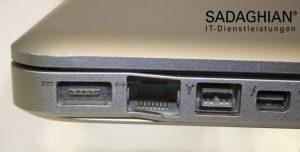Introduction

A defective port on your MacBook can severely impair the use of individual functions. Particularly common are mechanical defects or foreign objects that make individual ports unusable: for example, a broken headphone plug, bent USB-C or Thunderbolt sockets, or sand and other contamination that gets stuck in the port. The necessary repair measures depend significantly on the type of damage and the respective MacBook model.
Causes of Defective MacBook Ports
Mechanical Damage
Most damage occurs from mechanical stress: A headphone plug that breaks off in the audio port, bent contacts from forceful plugging or unplugging, or dropping the MacBook with the charging cable plugged in. This often damages the connection sockets themselves or their solder joints.
Foreign Objects in the Port
Ports can become blocked by sand, dust, or broken plug parts. Foreign objects prevent cables from being properly inserted or cause short circuits by bridging contacts.
Corrosion from Liquid
Even small amounts of liquid, condensation, or persistently high humidity are enough to cause long-term damage through corrosion at the sensitive contact points.
Repair Measures by Port Type
MacBooks have two different ways ports are built: modular ports (replaceable boards) and soldered ports (directly on the logic board).
1. Repair of Modular Ports (e.g., MagSafe, USB-A, Audio Port)
On older MacBook Air and Pro models, but also on the MagSafe 3 port of newer models, the ports are usually on separate I/O boards connected to the mainboard via cables.
Repair Measure:
- Replacement of the entire I/O board containing the defective port.
- Relatively simple procedure with short repair time.
2. Repair of Soldered USB-C and Thunderbolt Ports
On newer MacBook models from around 2016 onwards, USB-C and Thunderbolt ports are usually soldered directly onto the logic board. Mechanical damage or foreign objects in these ports require more complex measures.
Repair Measure:
- Using micro-soldering technology, the defective port is carefully removed from the logic board and replaced with a new one.
- Alternatively, replacing the entire logic board would be possible, but this is significantly more expensive and often unnecessary.
3. Removing Foreign Objects from Audio Ports or USB-C Ports
Broken headphone plugs, sand, or other foreign objects must be mechanically removed without damaging the port.
Repair Measure:
- Professional removal with special tools that avoid damage to the contacts.
- Subsequent cleaning and testing of the port's functionality.
4. Repair After Corrosion Damage
When moisture has penetrated and caused corrosion, simple cleaning is usually not sufficient.
Repair Measure:
- Removal of corrosion residues through ultrasonic cleaning.
- Replacement of corroded connection contacts or adjacent components using micro-soldering procedures.
Typical Symptoms of Defective MacBook Ports
A defective MacBook port can manifest through various symptoms:
- Charging problem: MacBook no longer charges or only sporadically
- Loose connection: Connection only works in certain cable positions
- No device recognition: External devices are no longer recognized
- Visible damage: Bent, broken, or corroded contacts
- Blocked ports: Cables can no longer be fully inserted
Preventive Measures
To avoid damage to MacBook ports, we recommend:
- Careful plugging and unplugging: Never force cables in or pull them out
- Regular cleaning: Occasionally clean ports with compressed air to remove dust
- Protection from moisture: Don't use MacBook in humid environments
- Care during transport: Don't leave cables plugged in during transport
Free Diagnosis
If you suspect a defective port, we offer a free diagnosis. We determine the exact cause and provide you with a transparent cost estimate for the repair. In many cases, repair is significantly cheaper than replacing the entire MacBook.
Conclusion
A defective port on a MacBook can often be fixed through targeted repair measures. The complexity and costs depend heavily on whether the affected ports are modular or soldered directly onto the logic board, and whether foreign objects, mechanical damage, or corrosion are the cause.
Professional repair services have the necessary tools and expertise to perform even complex port repairs without damaging the MacBook. Early diagnosis can often prevent major damage and keep repair costs low.